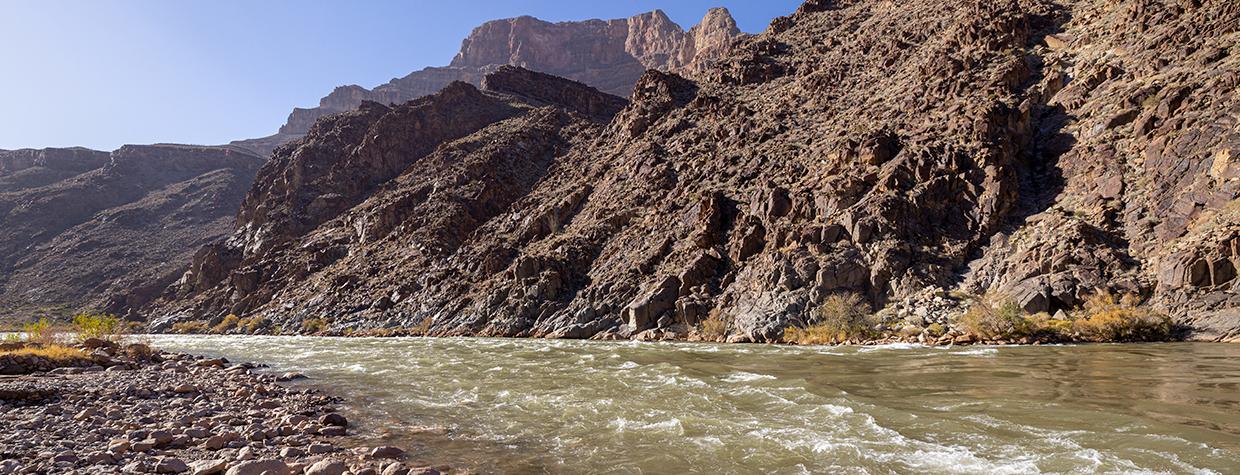On July 20, 1969, Neil Armstrong became the only person to have walked on the moon. And then, 19 minutes later, he wasn’t anymore. No disrespect to Buzz Aldrin, but the rare feeling of standing alone can be fleeting. But not when it comes to Diamond Creek Road. This rugged 20-mile route is the only place in the 277-mile Grand Canyon, from its start at Lees Ferry to its end at the Grand Wash Cliffs, where you can reach the Colorado River in a car. And the scenery along the way is just as unique.
You’ll need a high-clearance vehicle for this drive, and the road is on Hualapai Tribe land, so you’ll also need a permit. The place to get one is at the tribe’s Game and Fish Department, which is next to the Walapai Market, on the northwest corner of Historic Route 66 and Diamond Creek Road (Indian Route 6), in the tribal town of Peach Springs. Once you’re properly permitted, head north on Diamond Creek Road, which passes through a neighborhood before turning to dirt and gravel at Mile 1.2. Here, you’ll see rolling hills studded with piñon pines, junipers and creosote bushes as you start winding downhill.
The first real glimpse of the Canyon’s buttes comes a couple of miles in, and after you traverse a series of washes, the road curves to the right, around orange-red cliffs and a spring-fed patch of greenery. By Mile 5.5, you’ll get an excellent view of the Canyon to the north, and a mile later, the gorge’s layered buttes loom straight ahead. Here, the road gets rougher and narrower, a trend that will continue until you reach its northern terminus. And by now, the vegetation along the road has transitioned to prickly pears, yuccas and a few chollas, owing to the lower elevation.
Past a large wash crossing, you’ll see a massive rock wall straight ahead. This wall forms the western edge of Peach Springs Canyon, and as you curve into that landform, you’ll see some of the North Rim side of the Grand Canyon. Next are more wash crossings as the cliffs on both sides of the road gradually close in. Diamond Peak, a pyramid-shaped limestone formation that reaches a height of 3,501 feet, comes into view at Mile 15, and that’s when you’ll know you’re in the homestretch.
A few miles later, you’ll be in a landscape of ocotillos and dark red rocks. The road then curves to the northwest, and for its final mile, it follows Diamond Creek itself through a patch of relatively lush vegetation. This stretch is the most challenging of the drive, with numerous creek crossings and areas where water might be flowing on the road itself, depending on the season. Just past a parking area with picnic tables, the road ends at Diamond Creek Beach, where the creek empties into the mighty Colorado.
Here, the views in all directions are spectacular, from nearby Diamond Creek Rapids to tall buttes upstream and downstream. The road access to the beach makes this a popular takeout point for Canyon rafting trips, so you might have some company. If not, spend some time dipping your toes in the water and thinking about the fact that yours is the only car currently parked at the bottom of the Grand Canyon. If you’re lucky, you’ll get more than 19 minutes to think about it.
tour guide
Note: Mileages are approximate.
Length: 20 miles one way (from Historic Route 66)
Directions: From Historic Route 66 in Peach Springs, go north on Diamond Creek Road (Indian Route 6) for 20 miles to Diamond Creek Beach.
Vehicle requirements: A high-clearance vehicle, such as an SUV or truck, is required, but four-wheel-drive is not necessary in good weather. Don’t attempt the drive after recent rain or if rain is in the forecast.
Special consideration: The drive requires a permit from the Hualapai Game and Fish Department office in Peach Springs. Contact the department for permit costs and to ensure that the office and the road will be open when you plan to visit.
Warning: Back-road travel can be hazardous, so be aware of weather and road conditions. Carry plenty of water. Don’t travel alone, and let someone know where you are going and when you plan to return.
Information: Hualapai Game and Fish Department, 928-769-2227 or hualapai-nsn.gov/services/game-fish

